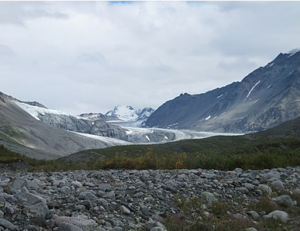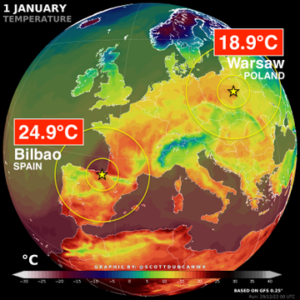Half the world’s glaciers will disappear within a single lifetime. Breaking science with Dr. David Rounce. Netherlands researcher Leon Simons: geoengineering has been cooling the planet for decades. That is over now. Co-author of the new bombshell from James Hansen tackles more warming revealed. Hansen predicts sea level rise much higher than thought and up to 10 degrees C hotter. If true, catastrophe is on the near horizon.
Listen to or download this Radio Ecoshock show in CD Quality (57 MB) or Lo-Fi (14 MB)
A WINTER HEAT WAVE IN EUROPE
But we cannot do anything without recording the crazy hot spell in Europe as 2023 began.
Europe is experiencing spring weather at the start of January. Too many all-time heat records to count were broken. “Normally” when a new heat level is breached for a particular day of the year, it will be half or one degree higher. This time, heat records in many European cities were 4 degrees C higher (7 F), even in a few places up to 10 degrees C. (20F) higher.
As Brett Wilkins reports in Common Dreams: “It’s ‘the most extreme event ever seen in European climatology,’ said one climatologist. ‘Nothing stands close to this.’” The headline is: “Absolute Madness’: Record-Shattering Heat Dome Hits Europe”. Meteorologist Scott Duncan said: “There are too many records to count. Literally thousands. Overnight minimum temperatures are like summer.” Duncan Tweets: “Warsaw in Poland just smashed its January record by over 5°C”. It was 66F (19C) in Warsaw. The average maximum is 33F or .5 C is average for maximum. People were out in t-shirts and shorts. in January. in Poland.
New heat records for January were also set in Hungary, Switzerland, Lithuania, Czech Republic, and Denmark. This comes after a serious cold spell lasting almost 2 weeks in North Europe. In the Northern Hemisphere, the waves of the Jet Stream go from Arctic cold to tropical hot these days. It was 21 degrees C (about 70 degrees Fahrenheit) in Bavaria on New Years eve!!
Europeans went to the beaches (in Spring jackets), and walked about town in glorious not-winter. Horticulturalists and farmers are nervous about possible impacts on the plant world. Unnatural gas prices dropped from stratospheric high prices to levels last seen before the pandemic. The high prices were based on a cold winter, and so far this isn’t. That is a relief to some of my European listeners and friends.
Climatologists have warned much of the warming we make will not just come as mega heat waves in summer. Winters will be warmer, especially in the Northern Hemisphere. The winters may be punctuated by brutal influxes of Arctic cold now and then, but when the totals are in, Northern winters will be warmer. In addition, as Scott Duncan noted, the nights will warm. Both winter warming and night warming are less visible to humans, and so we may miss this facet of climate change.
I won’t go in to all the reasons why warmer winters sound great for Canadians, Europeans, and all in the Northern Hemisphere. There are a lot of downsides to changing the seasons. Let’s just say bugs and food are involved, along with all wildlife and plants.
Europe is suddenly 4 degrees C hotter (about 7 deg. F). This comes after amazing heat waves last summer and the summer before. Remember? We begin to ask, has something in the climate shifted? Does warming come in steps rather than a gradual ramp of rising temperatures? I am working on a program addressing a possible cause for a jump in warming. You will hear part of that in my second interview, with Leon Simons.
First, we go to one of the biggest geophysical changes on a planet ever caused by a single species. Earth has just over 200,000 glaciers, splattered all over, from Alaska to the Andes, from Scandinavia to Nepal, Africa, all over. Around 100,000 of them will be gone during the lifetimes of our children. Let’s get this breaking science directly from the lead author.
==============================
Please help Radio Ecoshock keep going! This show is entirely funded by listeners and blog readers. There is no advertising, no junk to sell, and no corporate sponsors. If you can help, please do it here.
===============================
DAVID ROUNCE: HALF EARTH’S GLACIERS WILL VANISH
Hundreds of thousands of glaciers around the world will vanish in coming decades. This loss does not include Greenland or Antarctica, and these non-polar glaciers will add significantly to sea level rise. We talk with the lead author of the January 2023 paper titled “Global glacier change in the 21st century: Every increase in temperature matters”.
Dr. David Rounce is Assistant Professor of Civil and Environmental Engineering at Carnegie Mellon University. David previously conducted postdoctoral research in the Glaciers Group at the University of Alaska Fairbanks. He leads a team who measured every glacier on the planet and the news is not good.

In 2019, there was a funeral in Iceland for a glacier. It went extinct. Even small glaciers have their fans. Small glaciers may play a stabilizing role in local water cycles, influence regional weather, or have other cultural values.
Listen to or download my 20 minute interview with David Rounce in CD Quality or Lo-Fi
WATCH OUT FOR SEA LEVEL RISE!
A lot of previous studies used satellite images to map out over 200,000 glaciers on planet Earth. Looking at glaciers outside the Poles, this study considers scenarios from 1.5 degrees C. warming up to 4 degrees warming. Most scientists I talk to are done with 1.5 degrees. That is imminent. The paper finds:
“Even if the global mean temperature change is limited to +1.5°C, we estimate that 104,000 ± 20,000 glaciers (49 ± 9% of the total inventoried) will disappear by 2100 and at least half of those will be lost before 2050 (Fig. 1E). Most of the glaciers projected to disappear are <1 km2 (Fig. 2) but regardless of their small size, their disappearance may still negatively affect local hydrology, tourism, glacier hazards, and cultural values.”
Three degrees warming means these glaciers by themselves would add anywhere from three to six inches higher seas. Since emissions are not coming down, more scientists are considering 4 degrees of warming. At 4 degrees: 154 ± 44 mm Sea Level Elevation which translates to a range between 110 mm (4.3 inches) to 198 mm or 7.8 inches. There will be more sea level rise than previously reported (including the latest IPCC report).
Currently melting glaciers outside Greenland and Antarctica are contributing about the same amount of sea level rise as those major ice sheets. But as warming continues over the decades, those polar ice sheets are expected to provide far more sea level elevation.
It surprised me to learn the country outside Polar regions with the most glaciers is Pakistan. A 2013 Glacier Outburst flood killed thousands of tourists and religious pilgrims. These things can be deadly, and can even rearrange the landscape.
One ice-watcher suggested four top glaciers to watch. They are Presena in the Italian Alps, Chessjen (Swiss Alps), the Columbia glacier in Canada’s Rocky Mountains and of course the famous Himalayan Glaciers. David adds the Gulkana Glacier in Alaska, and several in Nepal. He spent so much time on glaciers, we could almost say glaciers were David’s classroom as he gained his Doctorate.

Our guest David Rounce led this study: “Global glacier change in the 21st century: Every increase in temperature matters”.
SEE ALSO:
World Could Lose Half of Glaciers This Century Even If Warming Is Kept to 1.5°C Julia Conley, Jan 05, 2023.
================================
LEON SIMONS: POLLUTION AND SUDDEN WARMING
You may know James Hansen as a leading climate scientist from NASA, the man who warned Congress about global warming in 1988. Hansen and his team have a new bombshell paper called “Global Warming in the Pipeline.” It is not yet peer-reviewed but out there on the net for comment. The paper is huge. Hansen says we have already reached a doubling point of greenhouse gas emissions, when we add in other global warming gases like methane, nitrous oxides and bunch of halogens.
The authors also claim mainstream science has underestimated the power of what will happen, now that the Earth is so far out of energy balance. That is disputed by other scientists.
Finally, as he has for at least a decade, Hansen again adds this up to find sea level rise will be much higher than we have been told. That does fit in with our first guest on disappearing glaciers. But Hansen and his colleagues think we could get several meters of sea level rise, say twelve feet or more, by the year 2100. That is apocalyptic for most of the world’s great cities and agricultural deltas.
The “Warming in the Pipeline’ paper is too big for one program. We start with just one of the most concrete and provable instances of hidden warming being revealed by a change in the atmosphere. This is the story of how clouds of pollution that cooled the sea and land are disappearing, letting in the full power of the sun.
LEON SIMONS: THE INTERVIEW
Our pollution actually helps cool the planet. New science warns as governments clear the air to save our health, Earth will experience more warming, faster than ever. The paper is called “Global Warming in the Pipeline”. It comes from a team led by former NASA scientist James Hansen. The paper is still up for peer review, but evidence has been building for years.
Among the authors, we find Leon Simons. Leon is not officially a climate scientist and yet James Hansen credits Leon’s contribution. Simons nailed a crucial change in ship emissions and cloud formation. Leon is an independent climate policy analyst and a Netherlands board member of the Club of Rome.

Listen to or download my 32 minute talk with Leon Simons in CD Quality or Lo-Fi
In September 2021, Hansen and Sato published a monthly temperature analysis from Columbia University’s Earth Institute. Science reporter Bob Berwyn reported it with the headline “The Rate of Global Warming During Next 25 Years Could Be Double What it Was in the Previous 50, a Renowned Climate Scientist Warns”. That sounds devastating. I see the latest paper “Global Warming in the Pipeline” as the most solid evidence for a theory building over the last ten years or so.
What is the source of human-made sulfur emissions? It is found in the oil that comes from the ground. Diesel transport used to emit sulfur, but that was removed from the fuel by law. A thicker fuel is used by ships. It is tar-like and has to be heated to use it in the engine. In the past 10 years that ship “bunker fuel” was 3.5% sulfur by weight. When burned it reacts with oxygen to become sulfur dioxide, which then reacts in the atmosphere to become a particle that can reflect light and help form clouds that also reflect light.
Leon says the cooling effect of sulfur is about half a degree C. About 20% is from reflection of the particles, and 80% from the sulfur effect on clouds. The smaller particles forms small water droplets, making clouds bigger and whiter, reflecting heat back to space. Simons Tweets: “Large scale reduction in SO2 emissions coincided with a cloud cover reduction of ~5% and an increase of annual sunshine of ~75 hours a year” [over Europe.]
Simons says the regulators never really thought about the climate impacts. They think they are doing a good thing by reducing ocean acidification and the number of people dying early due to pollution. The climatic impact of removing sulfates through regulations is very uncertain and an inconvenient truth, says Leon. Even the IPCC doesn’t really talk about it, even though these changes may increase warming up to about .5 degrees C. The public has not heard much about this.
CHECKING SHIP EMISSION THEORY
Leon Simons says clouds forming from ship emissions were hugely reduced almost as soon as new regulations drastically cutting sulfur from ships. That lets more sunlight hit the ocean, warming the seas. With all the satellite eyes in the sky, that should be easy to check. So I did.
In a press release dated October 28, 2022, NASA did indeed find, quote:
“A global standard limiting sulfur in ship fuel reduced artificial “ship track” clouds to record-low levels in 2020. Drawing on nearly two decades of satellite imagery, researchers found that the number of ship tracks fell significantly after a new fuel regulation went into effect. A global standard implemented in 2020 by the International Maritime Organization (IMO) – requiring an 86% reduction in fuel sulfur content – likely reduced ship track formation. COVID-19-related trade disruptions also played a small role in the reduction.”
The hard data is in found in a paper published July 22 of 2022 in the journal Science. The title is: “Global reduction in ship-tracks from sulfur regulations for shipping fuel”.
RAIN EFFECT
Let’s talk about human pollution and rain. Some suggest human-made particles in clouds decrease rainfall because they are too small to form rain. In December 2022, new science was published shedding more light on that, . Professor Gannet Hallar and colleagues at University of Utah found small aerosol particles can indeed grow into cloud condensation nuclei. Leon talks us through the uncertainty of clouds and why they matter so much for our future climate.
THE TWO IRONIES:
1. A group of non-scientists have long claimed there is a conspiracy to cool Earth already, by spraying something into the air. They focus on alleged airplane emissions, resulting in what they term “chemtrails”. It turns out that “chemtrails” are real, but not secret at all, though poorly measured. These came from airplanes, but also from diesel trucks and especially ships burning high-sulfate forms of oil.
2. One of the biggest concerns about geoengineering like injection of sulfates into the upper atmosphere, is: what is it stops, for any reason from economic breakdown to war or political change. Well now we know: there was an inadvertent geoengineered cooling from sulfate-laden fuels, and coal burning, and now that has been slashed in half or more. We are experiencing the impacts of “termination shock” right now, Simons says.
There is a novel called “Termination Shock”. It suggests we would have to cut 20 times more carbon to offset the change in sulfur emissions.

GEOENGINEERING – DIMINISHING RETURNS
That July Science paper also said: “The global 2020 fuel standard is likely a watershed moment that will permanently reduce the population of detectable ship-tracks.” The authors say: “Such studies will also help assess the effectiveness and impact of deliberate marine cloud brightening as a geoengineering option.”
There lies a problem for artificial solutions like cloud seeding. A paper published October 3rd, 2022 led by Duncan Watson-Parris found the catch. The title is: “Shipping regulations lead to large reduction in cloud perturbations.” This is from that PNAS paper:
“While locally the relative sensitivity of ship track formation to emissions changes can be as large as 1.0, there is large spatial variability and the global change in the number of tracks is clearly sublinear: An 80% reduction in SOx emissions causes only a 25% reduction in the number of tracks detected.
Since the change in droplet number is known to respond logarithmically with increased condensation nuclei, this demonstrates how far from their preindustrial conditions the shipping corridors are, even after such a large reduction in emissions. It also highlights the difficulty faced by proposed marine cloud brightening efforts due to the diminishing returns on injected aerosol.”
This is a new objection to marine cloud brightening aiming to save us from our own emission Hell. It sounds like we would have to pump more and more particles into the stratosphere just to keep the same effect. Or maybe it weakens until it doesn’t work. Nobody knows.
But like most things in science, some object to the cooling claimed by Leon Simons. A study led by Franziska Glassmeier in Science, 2021 found:
“Studies of stratocumulus cloud tracks that are formed by ship exhaust have been used to estimate the radiative impact of this process, but Glassmeier et al. now show that this approach overestimates the cooling effect of aerosol addition by up to 200%.”
Ship-track clouds have been studied since the first satellites were launched in the early 1980s. But the operations of clouds are still, well, cloudy. We learn new things all the time. A study published last October in Nature found: “only a small fraction of the clouds polluted by shipping show ship tracks.” There is a lot of pollution from ships that doesn’t form wispy clouds and cannot be seen by satellites. Even the unseen particles from ships can cause cooling though.
Our guest Leon Simon knows all this, and warned us there is still a lot of uncertainty about how clouds work, and how much cooling they may give us in future. Remember our 2019 interview with NASA’s Tapio Schneider. They found a ceiling of greenhouse gases, possibly starting around 1200 parts per million, where the massive low clouds famous in the Tropics could no longer form. That would be a significant loss of cloud cooling, leading to another wave of warming on this planet. But we are only about half way to that 1200 ppm deadline.
LEON SIMONS YOUTUBE PRESENTATION
You can dig into Leon’s work on ship emissions and rapid heating in this helpful YouTube presentation. Peter Dynes from MEER hosts Leon as he goes through the graphs and facts about sulfate aerosols and “termination shock”.
Leon says sulfur emissions from shipping has been reduced by 80% in 2020, because of changes in regulations and the sulfur fuel content. For shipping went from about 3% to .5% starting in January 2020. There was also a significant decrease in 2015 due to North American fuel changes.
The IMO, International Maritime Organization shows a lot of uncertainty in how much sulphur has been removed. It could be almost no affect on warming or a very significant push to rapid warming. We don’t know yet.
The Northern Hemisphere is the main place where sulfur from ships is emitted. There is where most shipping is. So some of the warming could be amplified in the North Atlantic and North Pacific Oceans when shipping emissions are cut. He talks as though “regional” warming will happen, before it spreads to become global.
Follow Leon Simons on Twitter.
Who knew we were the cloud-makers? Why did the chemtrails people point to clouds from aircraft emissions, when ships and coal-burning power plants were really cooling the planet? And we talked about geoengineering as a future thing – while this civilization did it for decades. Right now, as Leon Simons told us, we are finding out what happens when you rapidly remove polluting but cooling particles from the Earth. We are getting a small dose of “termination shock.”
Enjoy your warmer winters, but know they come with a price tag bigger than we can afford.
Next week we will tackle Hansen’s big new paper. I heard back from James Hansen. He says the interview has to wait until the new paper is peer-reviewed and ready for publication. Next week, I will do my best to pass on the science and the news about Global Warming in the Pipeline.
I’m Alex Smith. Thank you for listening to Radio Ecoshock this week, and caring about our world.

why do scientists say processes as process seas? Does anyone find this is annoying?
Pingback: Humankind is suicidal; and Satanic scientists | D Bradley's Blog